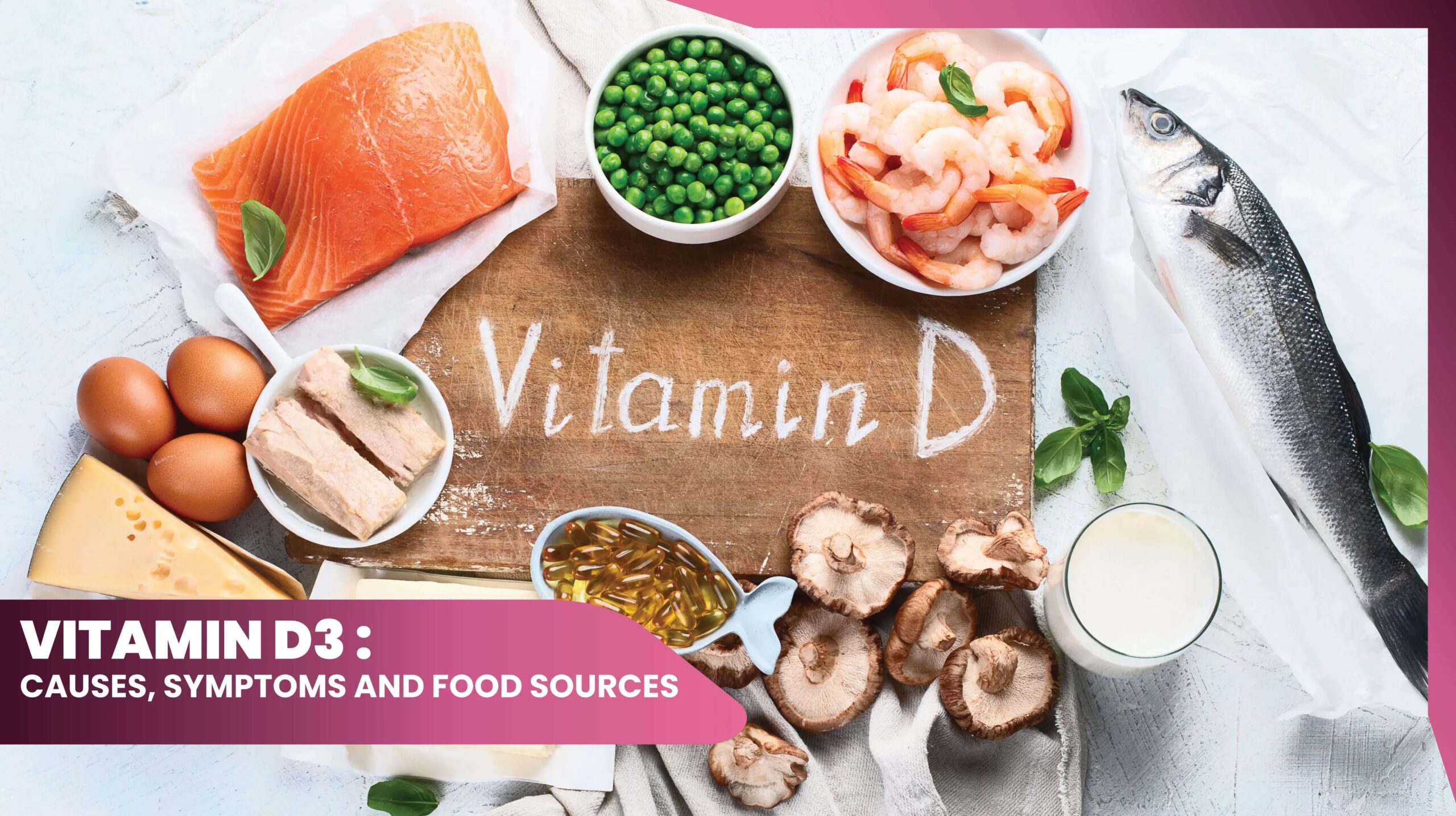Vitamin D also called sunshine vitamin is the most easily available vitamin. Vitamin D is formed in the body when your skin is exposed to sunlight. The process of vitamin D synthesis begins when your skin is exposed to ultraviolet B (UVB) rays from sunlight. When you spend time outdoors in the sunlight, specifically UVB rays from the sun interact with a type of cholesterol molecule in your skin called 7-dehydrocholesterol. UVB radiation causes a chemical reaction in 7-dehydrocholesterol, converting it into a compound known as pre-vitamin D3. Pre-vitamin D3 is not yet active vitamin D. To become active, it needs further processing. This occurs naturally due to body heat, particularly in the skin. The heat-induced conversion of pre-vitamin D3 forms vitamin D3, also known as cholecalciferol.
Difference between Vitamin D2 and Vitamin D3
Vitamin D2 (ergocalciferol) and vitamin D3 (cholecalciferol) are two different forms of vitamin D, and they have some differences in their sources, bioavailability, and usage.
- Sources: Vitamin D2 is primarily obtained from plant-based sources. It is synthesized by certain types of fungi, and it can be found in some foods like fortified cereals and plant-based milk substitutes. It’s commonly found in plant products whereas Vitamin D3 is the form of vitamin D that is naturally produced in the skin when exposed to sunlight (UVB radiation). It is also found in some animal-based foods, such as fatty fish (e.g., salmon, mackerel, and tuna), egg yolks, and small amounts in beef liver.
- Bioavailability: Vitamin D3 is considered to be more bioavailable and effective at raising blood levels of vitamin D compared to vitamin D2.
- Medical Use: Both vitamin D2 and D3 can be used medically to treat vitamin D deficiency or related conditions. However, vitamin D3 is generally preferred because of its superior bioavailability.
- Fortification: In many countries, vitamin D2 is used for fortification of certain foods, such as plant-based milk alternatives and breakfast cereals. However, some food products and supplements may contain vitamin D3 as well.
6 Food Sources of Vitamin D3
Let us have a quick view of all these food sources
- Meat of fatty fish
- Fish liver oils
- Salmon and tuna
- A small amount of vitamin D3 is also found in egg yolks
- Orange juices
- All cereals and dairy products are fortified with vitamin D3.
What are the symptoms of Vitamin D3 deficiency?
Vitamin D3 plays a significant role in maintaining the health of your bones, immune system, and overall well-being. A deficiency in vitamin D3 can lead to a range of symptoms and health issues. Here are 10 common symptoms and deficiencies associated with vitamin D3:
- Osteoporosis: A deficiency in vitamin D3 can lead to weaker bones, increasing the risk of fractures and osteoporosis, a condition characterized by fragile bones.
- Muscle Weakness and Pain: Vitamin D3 is essential for muscle function, and a deficiency can lead to muscle weakness. Some people with low vitamin D3 levels may experience muscle aches and pains.
- Impaired Immune Function: Vitamin D3 plays a role in supporting the immune system. A deficiency may result in increased susceptibility to infections and illness.
- Fatigue: Some individuals with low vitamin D3 levels may experience fatigue and a general sense of tiredness.
- Mood Disorders: Low vitamin D3 levels have been associated with mood disorders such as depression and seasonal affective disorder (SAD).
- Cognitive Impairment: There is some evidence to suggest that vitamin D3 deficiency may be linked to cognitive decline and an increased risk of conditions like dementia.
- Hair Loss: Although more research is needed, some individuals with vitamin D3 deficiency have reported hair loss or thinning.
- Bone Deformities in Children: In severe cases of vitamin D3 deficiency, children may develop rickets, a condition characterized by bone deformities, delayed growth, and developmental issues.
- Impaired Wound Healing: Vitamin D3 is important for wound healing and tissue repair. Deficiency can slow down these processes.
- Increased Risk of Chronic Diseases: Some studies have suggested that low vitamin D3 levels may be associated with an increased risk of chronic diseases such as cardiovascular disease, diabetes, and certain cancers.
8 Functions of Vitamin D in our body
Vitamin D is a fat-soluble vitamin that plays several crucial roles in the body. Its primary functions include:
- Calcium and Phosphorus Absorption: One of the most well-known functions of vitamin D is its role in promoting the absorption of calcium and phosphorus from the intestines. This is essential for maintaining healthy bones and teeth.
- Bone Health: Vitamin D helps regulate calcium levels in the blood, which is necessary for bone mineralization. It ensures that calcium is deposited in bones, making them stronger and less susceptible to fractures. A deficiency can lead to conditions like osteoporosis and rickets.
- Muscle Function: Vitamin D is involved in muscle contraction and function. It helps maintain muscle strength, and a deficiency can lead to muscle weakness and pain.
- Immune System Support: Vitamin D plays a role in supporting the immune system. It helps the body defend against infections and may reduce the risk of autoimmune diseases. Adequate vitamin D levels are important for a well-functioning immune response.
- Cell Growth and Regulation: Vitamin D is involved in regulating cell growth and differentiation. It may have a role in controlling cell proliferation and preventing the development of certain cancers.
- Hormone Regulation: Vitamin D is involved in the regulation of various hormones in the body, including insulin and parathyroid hormone (PTH). Proper regulation of these hormones is essential for overall health.
- Mood and Mental Health: Some research suggests that vitamin D may have an impact on mood and mental health. Low levels of vitamin D have been associated with an increased risk of mood disorders like depression and seasonal affective disorder (SAD).
- Heart Health: There is ongoing research into the potential cardiovascular benefits of vitamin D. Some studies suggest that adequate vitamin D levels may help reduce the risk of heart disease and hypertension.
- Skin Health: Vitamin D is synthesized in the skin when it is exposed to sunlight. It plays a role in maintaining the health of the skin and may help with conditions like psoriasis.
- Regulation of Blood Pressure: There is some evidence to suggest that vitamin D may play a role in regulating blood pressure. Adequate levels of vitamin D may help maintain healthy blood pressure levels.
Conclusion
Vitamin D is essential for our overall healthy metabolism. But its deficiency is seen in every 1 out of 3 persons, we can say that its deficiency is spreading like a silent epidemic. If you notice any one of the above symptoms in your body, then you must enquire for a checkup of the levels of both Vitamin D3.
In case of a report of any of the deficiency symptoms, a consultation with a health professional must be done. Supplements should not be for a long time but only for a limited time when you are seriously deficient in their levels. A lifelong healthy and balanced diet is the only cure for the deficiency of this vitamin





